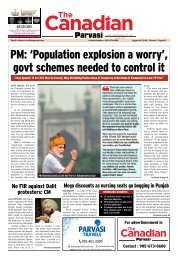Create successful ePaper yourself
Turn your PDF publications into a flip-book with our unique Google optimized e-Paper software.
<strong>The</strong> International News Weekly Edit<br />
06<br />
August 16, 2019 | Toronto<br />
<strong>The</strong><br />
w w w . canadianparv asi. c o m<br />
Publisher & CEO<br />
Associate Editor<br />
Editor (India)<br />
Online<br />
Graphic Designer<br />
Official Photographer<br />
Contact<br />
Editorial<br />
Sales<br />
Rajinder Saini<br />
Meenakshi Saini<br />
Gursheesh<br />
Kshitiz Dalal<br />
Naveen<br />
Bashir Nasir<br />
editor@canadianparvasi.com<br />
sales@canadianparvasi.com<br />
Do What It Takes<br />
On 73rd Independence Day<br />
it is India’s economic future<br />
that is in focus<br />
<strong>The</strong> identity of this government is that it<br />
neither avoids problems nor lets them fester. So<br />
said Prime Minister Narendra Modi in his Independence<br />
Day address to the nation from the<br />
ramparts of the Red Fort. He was referring to<br />
the momentous decision to nullify Article 370. In<br />
this view, a temporary provision came to endure<br />
for seven decades because earlier governments<br />
lacked the courage for course correction. A like<br />
charge can be laid at the Modi government’s<br />
door, on the economy front.<br />
Signs of a worrying slowdown are all around.<br />
However, the PM says that every citizen should<br />
be dreaming of India becoming a five trillion dollar<br />
economy in the next five years, which means<br />
that instead of the usual incremental progress it<br />
is time to “jump high”. Such exponential progress<br />
requires confronting the problems that are<br />
holding up the economy.<br />
Indeed, the PM called for honouring wealth<br />
creators and touched on the need to expand exports,<br />
which implies a reversal of the current approach<br />
of piling on taxes, tariffs, harassment by<br />
tax agencies, high spectrum charges and the like<br />
– a ‘maximum government’ approach that ends<br />
up hobbling the global competitiveness of the<br />
Indian economy. One concrete outcome of the<br />
speech was Modi’s announcement of his government’s<br />
decision to deliver on the long pending<br />
demand for a chief of defence staff for the Indian<br />
armed forces – essential for its modernisation<br />
and integration and hanging fire since establishing<br />
such a post was recommended after the 1999<br />
Kargil war.<br />
If the PM’s first term was signatured by the<br />
Swachh Bharat campaign, a similar role in the<br />
second term may be performed by the Jal Shakti<br />
Abhiyan. With many areas suffering drought followed<br />
by flooding in recent months it is obvious<br />
that India’s water infrastructure and administration<br />
need a radical makeover. More efficient<br />
use of water is, indeed, a necessary ingredient<br />
for India’s economic revitalisation. For such revitalisation,<br />
and if India is to hit the $5 trillion<br />
target, the government must display decisiveness<br />
similar to that which it is willing to exhibit<br />
on the security front.<br />
It needs to get out of the business of running<br />
businesses, including most public sector banks,<br />
and to courageously reform the factor markets<br />
that have been making India increasingly uncompetitive.<br />
TNN<br />
Regain India’s Textile Glory<br />
How to reverse the slide in apparel exports and<br />
ride a high growth path<br />
Ajay Srivastava<br />
A look at last year’s<br />
apparel export figures<br />
is chastening. China exported<br />
$145 billion, Bangladesh<br />
$36 billion, Vietnam<br />
$33 billion and India<br />
a mere $17 billion. India<br />
is far behind China and<br />
steadily losing to smaller<br />
countries.<br />
<strong>The</strong> biggest reason is<br />
India’s near absence from<br />
the main product category<br />
that accounts for 70% of<br />
world trade in apparels –<br />
synthetic apparels. Today,<br />
most formal, sports and<br />
fashion wear uses synthetic<br />
fabrics. <strong>The</strong>y are durable,<br />
do not fade, can have<br />
any colour. Easy blending<br />
with wool, cotton, or rubber<br />
allows experimentation.<br />
Unsurprisingly, synthetics<br />
have overtaken<br />
cottons and become favourites<br />
of the fashion industry.<br />
With weak synthetics,<br />
India’s apparel industry is<br />
a horse running with one<br />
leg tied. <strong>The</strong> results are<br />
low exports, low wages,<br />
and low investments in<br />
the sector. Here is how.<br />
Globally cotton dominates<br />
spring and summer<br />
sales seasons. Synthetics<br />
and blends dominate<br />
autumn and winter seasons.<br />
Indian units run six<br />
months a year to produce<br />
cotton apparels. In the remaining<br />
six months, most<br />
units are shut or run at a<br />
low capacity as they do not<br />
have orders for synthetics/<br />
winter wear. Most<br />
workers go home.<br />
Also, a factory that<br />
runs only six months a<br />
year still has to pay the full<br />
year’s fixed costs – rent,<br />
salary for minimal staff,<br />
interest on loans, etc. This<br />
makes anything made in<br />
the factory expensive.<br />
Absence from synthetics<br />
also affects workers’<br />
wages. Winter wears are<br />
more expensive than informal<br />
cotton wear. So, at<br />
20% labour cost, a worker<br />
making a suit would earn<br />
more money than the<br />
worker making a blouse.<br />
Since India is mainly an<br />
informal cotton wear exporting<br />
country, wages<br />
remain at minimal levels.<br />
Entry into synthetics<br />
would make factories run<br />
full year, and increase<br />
wages manifold.<br />
Why is India weak in<br />
synthetics? Here are three<br />
major pain points.<br />
One, expensive raw<br />
material. India is almost<br />
a captive market for a few<br />
large firms that produce<br />
90% of the synthetics raw<br />
materials consumed in India.<br />
Domestic prices are<br />
tied to import prices. And<br />
imports are expensive because<br />
of high customs and<br />
anti-dumping duties on<br />
raw materials like PTA,<br />
PSF, PFY, acrylic fibers,<br />
etc. Duty-free imports to<br />
exporters offer some relief,<br />
but the domestic synthetics<br />
ecosystem remains<br />
stunted.<br />
Two, weak weaving<br />
and processing. <strong>The</strong> textile<br />
value chain consists<br />
of yarn making, weaving,<br />
fabric processing and apparel<br />
making. Weaving<br />
and fabric processing are<br />
the weak links that threaten<br />
to fragment this chain,<br />
forcing the export of yarn<br />
and import of fabric.<br />
Most weaving and processing<br />
units are small,<br />
informal units that lack<br />
expertise, scale and technology.<br />
Power outage and<br />
reduced capacity use doubles<br />
the cost of weaving in<br />
India, making it as expensive<br />
as in the EU or US.<br />
Fabric processing<br />
faces similar issues. Chinese<br />
units process 10 lakh<br />
metres of cloth a day, Indian<br />
units less than 20,000<br />
metres. For large orders,<br />
Indian units do batch<br />
processing that often results<br />
in output with varying<br />
shrinkage, feel and<br />
shades. Also, most Indian<br />
processors are struggling<br />
to meet the zero-liquid discharge<br />
(ZLD) norms set by<br />
Madras high court in 2011.<br />
Not surprisingly,<br />
while India is the number<br />
one yarn exporter (India<br />
23% share, China 13%)<br />
when it comes to fabrics,<br />
performance falls (India,<br />
6%, China 52%). Yarn sector<br />
has large units, while<br />
weaving and processing<br />
happen in small informal<br />
units.<br />
Three, low preparedness<br />
of Indian exporters<br />
to meet the demands of<br />
the fast fashion industry<br />
(FFI). Key FFI players are<br />
the low-cost retailers like<br />
Walmart, high fashion<br />
brands like Zara, H&M,<br />
Gap, and online-only retailers<br />
like Amazon, Zalando.<br />
<strong>The</strong>y conjure new<br />
fashion trends and convert<br />
designs into affordable<br />
clothing within a few<br />
weeks. Any delay means<br />
a change in fashion and<br />
the product ending into<br />
surplus. This forces FFI<br />
to place orders only with<br />
firms that deliver fast and<br />
are compliant with labour<br />
and other rules.<br />
Cost is an important<br />
issue. One metric used by<br />
FFI for making payments<br />
to apparel manufacturers<br />
is standard allowed minute<br />
(SAM). It measures<br />
the time taken in making<br />
a garment. FFI firms<br />
compare SAM across<br />
manufacturers and countries<br />
while placing orders.<br />
Skilled labour and the latest<br />
technology are a must<br />
to ensure a good SAM.<br />
80% of Indian exporters<br />
do not meet SAM or other<br />
requirements. A three step<br />
plan will unshackle the<br />
sector and set it on a high<br />
growth path.<br />
One, lower import duties<br />
on synthetics raw materials.<br />
Lower duties will<br />
bring down the prices by<br />
30% to 50%, almost at par<br />
with global prices. This<br />
would free the apparel<br />
industry to scale up and<br />
invest in synthetics. Without<br />
low import duties, the<br />
synthetics industry and<br />
hence exports cannot take<br />
off in a big way.<br />
Two, strengthen the<br />
weaving and processing<br />
segments. Only large units<br />
with the latest technology<br />
can meet the quality<br />
requirements. Setting up<br />
ten big scale weaving and<br />
processing units could be<br />
an annual goal. High investments<br />
in the latest machinery<br />
set Chinese industry<br />
on a high growth path.<br />
Three, take priority<br />
action to make more<br />
factories FFI compliant.<br />
<strong>The</strong> good news is India<br />
has about 1,200 compliant<br />
factories supplying cotton<br />
products to FFI and<br />
other large buyers. Many<br />
of these would invest in<br />
synthetics and export new<br />
products to the same set of<br />
buyers. Indian has a rich<br />
textile heritage with thousands<br />
of firms and skilled<br />
craftsmen. <strong>The</strong> suggested<br />
actions would make us a<br />
significant player in apparel<br />
trade. <strong>The</strong> industry<br />
engages 50 million people.<br />
Change will benefit everyone<br />
associated.<br />
Source Credit: This article<br />
was first published in <strong>The</strong><br />
Times of India. <strong>The</strong> writer is an<br />
Indian Trade Service officer.<br />
Views are personal<br />
<strong>Parvasi</strong> weekly & people associated with it are not responsible for any claims made by the advertisement & do not endorse any product or service advertised in <strong>Canadian</strong> <strong>Parvasi</strong>. Please consult your lawyer before buying/hiring/contracting through the<br />
advertisement Publised in this newspaper. <strong>The</strong> <strong>Canadian</strong> <strong>Parvasi</strong> is in the business of selling space and the clains made by the advertisement are not tested/confirmed by an independent source.
















